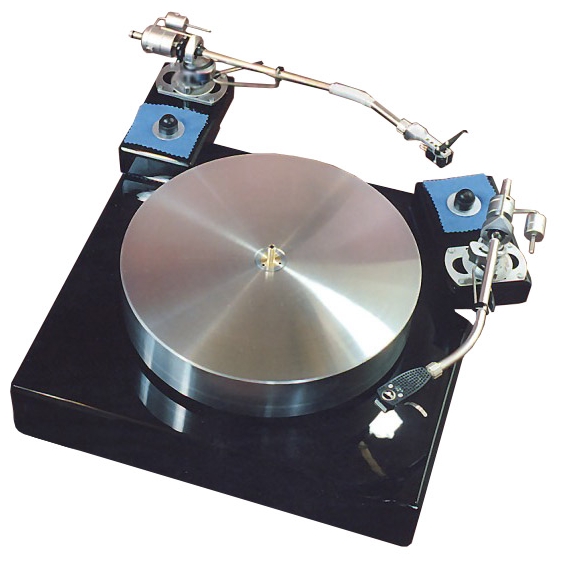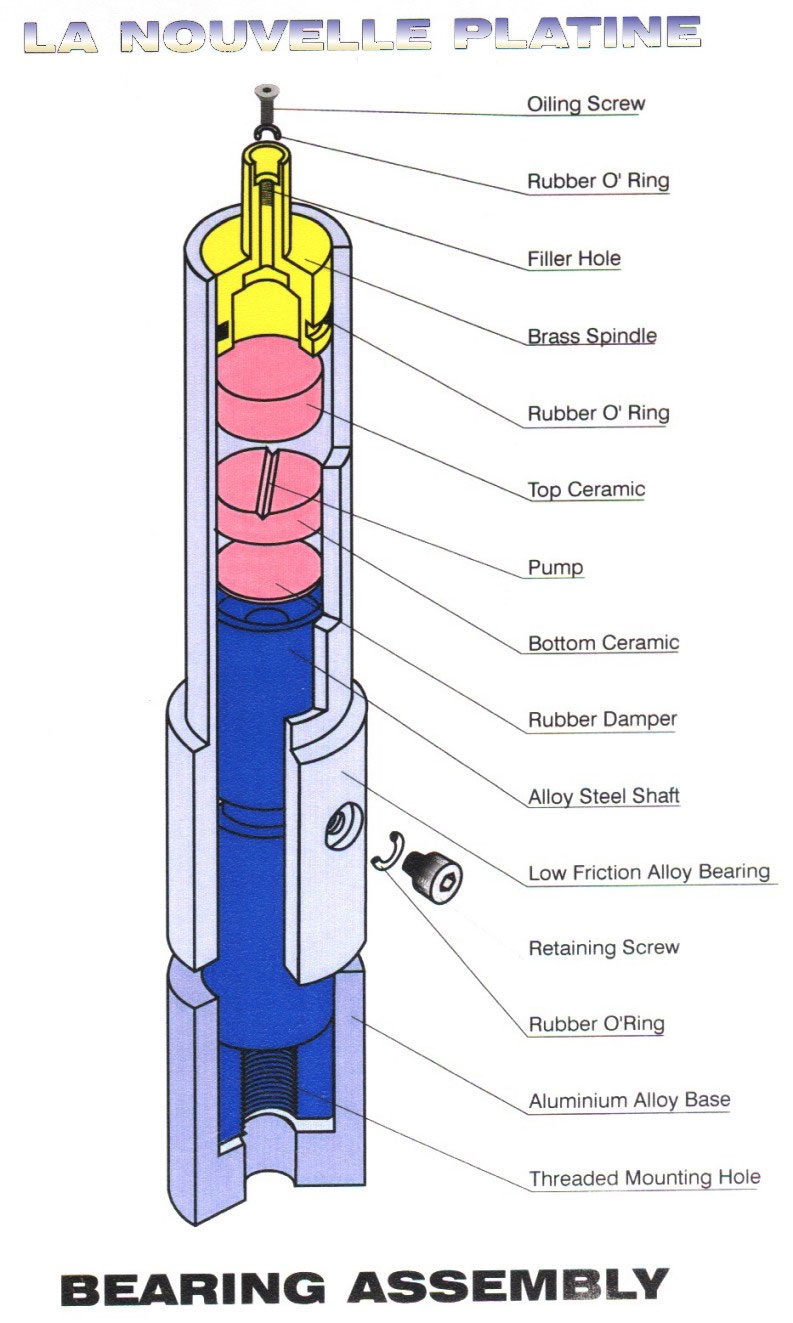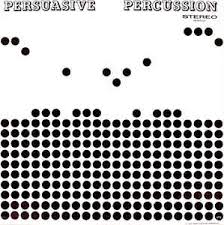J.C.Verdier La Nouvelle Platine Turntable

I remember reading somewhere a particular French amplifier being described as one which you don’t just buy, but one which you have a love affair with. The writer went further. He said (and I paraphrase) “buy it, and get laid more”.
 Surely, this sounds like a lonely audiophile’s wet dream. Scenes of a comely blonde in a long flowing silk dress, draped over the couch, getting drunk on the lush sounds of Edith Piaf from the hifi system, eyes closing as the lonely audiophile sees his opportunity to lean over and meet those luscious lips with his own… until the neighbour screams, “Turn that stupid stereo down, will ya?” Oh well, so much for getting laid more. I am sorry to disappoint any octogenarian audiophiles here, but hifi is no longer the aphrodisiac that it used to be in the 1960s, if it ever was. Perhaps it was all the result of a marketing conspiracy to make us believe that women will find us more attractive if we get into this hobby. Proof again that if something sounds too good to be true, then it usually under-delivers on its promises.
Surely, this sounds like a lonely audiophile’s wet dream. Scenes of a comely blonde in a long flowing silk dress, draped over the couch, getting drunk on the lush sounds of Edith Piaf from the hifi system, eyes closing as the lonely audiophile sees his opportunity to lean over and meet those luscious lips with his own… until the neighbour screams, “Turn that stupid stereo down, will ya?” Oh well, so much for getting laid more. I am sorry to disappoint any octogenarian audiophiles here, but hifi is no longer the aphrodisiac that it used to be in the 1960s, if it ever was. Perhaps it was all the result of a marketing conspiracy to make us believe that women will find us more attractive if we get into this hobby. Proof again that if something sounds too good to be true, then it usually under-delivers on its promises.
But, in the world of audiophiliac lore, there is indeed one product from France that qualifies as a legend, and does deliver on what it promises. Maybe the French, inveterate lovers that they are, have successfully found a way to imbue inanimate objects with the quality of seductiveness. I am talking about La Platine Verdier, made by the famous turntable meister, Mr Jean C. Verdier. JC Verdier, as he is better known, passed away in 2014 suddenly, but left behind a company and a turntable bearing his name which are both destined to live on long after his passing. The flagship turntable, the Platine Verdier, famously makes use of magnetic repulsion forces that obviates the need for a thrust bearing. Opposites repel and also attract being the principle, in love and turntable bearings, I presume? It is still belt-driven, but because of the magnetic bearing, it is claimed that both bearing and surface noise are radically reduced. Understandably, the level of engineering required to float a 35 lbs. piece of metal on an invisible bed of magnetic forces costs quite a pretty penny, and for years JC Verdier wrestled with the notion of creating a less costly version of his La Platine Verdier, but without sacrificing the high standards of which his classic turntable has achieved and is justifiably known for.

LAST TANGO IN PARIS, ANYONE?
The story (which can be found on the JC Verdier website) goes that one day, while listlessly buttering his toast, a lightbulb went off in his head. At just the right temperature, the butter was of the perfect consistency to float his knife off the surface of the bread, allowing him to move the knife back and forth effortlessly. Well that slab of butter is long gone, hopefully not used for purposes for which its makers never intended, but its lubricative qualities was instrumental in inspiring the successor to the Platine Verdier, the Nouvelle Platine which was launched sometime in the late 1990s. Yes, this “new” turntable is almost two decades old.
 JC Verdier’s stroke of genius was to figure out how to design two “knife” blades set at a 120⁰ angle to each other, spreading a layer of oil over which the entire platter’s weight can rest and rotate smoothly. JC Verdier himself admits that the degree of accuracy with which the components of an oil bearing must be produced would not have been possible a few decades ago without the aid of modern CNC machines.
JC Verdier’s stroke of genius was to figure out how to design two “knife” blades set at a 120⁰ angle to each other, spreading a layer of oil over which the entire platter’s weight can rest and rotate smoothly. JC Verdier himself admits that the degree of accuracy with which the components of an oil bearing must be produced would not have been possible a few decades ago without the aid of modern CNC machines.
For those who are familiar with idler-drive decks, in particular the Garrards, it is important not to confuse the JC Verdier oil bearing with the oil or grease impregnated bearing used by the Garrards which still employ a thrust pad at the base. In the Nouvelle Platine, the oil is not just used for lubrication but to actually support the entire weight of the platter. The closest analogy I can think of is the hydraulic lift which uses pressurized liquid to create an upward force, and most of us would at least have a passing familiarity with how powerful such hydraulic systems can be.
In keeping with its older sibling, the Nouvelle Platine is driven by a high-torque Philips outboard motor that uses either a rubber belt or a loop of linen thread to connect to the platter. Some listeners believe that linen sounds better as it gives better speed consistency since it does not age and lose its elasticity. The motor is free-sited and decouples any nasty vibrations caused by it from the turntable itself, further enhancing its operational quietness.
 It would be remiss of me not to mention that, since its inception, many audiophiles around the world have fallen head over heels for this deck, and it has become somewhat fertile ground for many a tweaker seeking to gild the lily. In particular, a German audiophile and manufacturer called Keith Aschenbrenner (of Auditorium 23 fame) had a űber-tweaked version commissioned which is claimed to sound so good, it actually rivals the Platine Verdier in sonic quality. However, before you start getting any ideas, you are unlikely to be able to purchase that version since territorial license restrictions prohibit JC Verdier from selling it outside of Deutschland. Unless you happen to be living in Germany, of course. So the caveat here is that the rest of this review is based on the French version which is available to desperate non-Teutonic lovers in the rest of the world.
It would be remiss of me not to mention that, since its inception, many audiophiles around the world have fallen head over heels for this deck, and it has become somewhat fertile ground for many a tweaker seeking to gild the lily. In particular, a German audiophile and manufacturer called Keith Aschenbrenner (of Auditorium 23 fame) had a űber-tweaked version commissioned which is claimed to sound so good, it actually rivals the Platine Verdier in sonic quality. However, before you start getting any ideas, you are unlikely to be able to purchase that version since territorial license restrictions prohibit JC Verdier from selling it outside of Deutschland. Unless you happen to be living in Germany, of course. So the caveat here is that the rest of this review is based on the French version which is available to desperate non-Teutonic lovers in the rest of the world.
A note about the rest of the system: the tonearm is a 12” Jakutis unipivot (from Lithuania), with an Audio Technica AT33SA Shibata line-contact cartridge. The phono stage is the Japanese Aurorasound Vida.
The question on all our lips is, given the fact that the Nouvelle Platine was rolled out as a less expensive sibling to the Platine Verdier almost 20 years ago, how does it actually perform now? And how does it stand up to the test of modern ears attuned to a different aesthetic than was popular at the time this deck was born?
SOUND QUALITY
Extremely well thank you very much, seems to be the short answer to a long and – Verdier die-hards will maintain – rather needless question.
 From the very first track, the Nouvelle Platine distinguished itself with a clean, focused presentation that broke free of the speakers. TakeDake’s Asian Roots album (Denon CY18072) was a good starting point because it had clearly defined positioning of musicians in the recorded soundstage. The Nouvelle Platine was able to place each musician distinctly within that soundstage with no blurring of lines between instruments, and, as promised, a level of surface noise so low that it beggared belief. Despite the thick heavy platter, or perhaps because of it, sound images were solid and never once wavered. John Neptune Kaizan’s shakuhachi in the track Japanese Roots was perfectly carved in space right in the middle of the speakers, with big bamboo blocks on the left and smaller ones on the right. The Nouvelle Platine was also able to keep up with fast transients – percussive accents were tightly reproduced, rhythmically propulsive and tonally convincing.
From the very first track, the Nouvelle Platine distinguished itself with a clean, focused presentation that broke free of the speakers. TakeDake’s Asian Roots album (Denon CY18072) was a good starting point because it had clearly defined positioning of musicians in the recorded soundstage. The Nouvelle Platine was able to place each musician distinctly within that soundstage with no blurring of lines between instruments, and, as promised, a level of surface noise so low that it beggared belief. Despite the thick heavy platter, or perhaps because of it, sound images were solid and never once wavered. John Neptune Kaizan’s shakuhachi in the track Japanese Roots was perfectly carved in space right in the middle of the speakers, with big bamboo blocks on the left and smaller ones on the right. The Nouvelle Platine was also able to keep up with fast transients – percussive accents were tightly reproduced, rhythmically propulsive and tonally convincing.
 Because the Nouvelle Platine’s percussion performance was so good, I could not help but dig out that old percussion standby, Enoch Light’s Persuasive Percussion (Top Music TMLP-9013-3) and cue up Whatever Lola Wants. This 180g re-issue, by the way, gives greater depth of perspective to the instrumental sound field compared with the original pressing, which is especially apparent when listening to the snare drum (here with the snare wires disengaged for the song’s A sections). I loved the way the Nouvelle Platine brought out the different pitches and tonalities of each percussion instrument and this, in combination with snappy transients, produced a very satisfying listening experience.
Because the Nouvelle Platine’s percussion performance was so good, I could not help but dig out that old percussion standby, Enoch Light’s Persuasive Percussion (Top Music TMLP-9013-3) and cue up Whatever Lola Wants. This 180g re-issue, by the way, gives greater depth of perspective to the instrumental sound field compared with the original pressing, which is especially apparent when listening to the snare drum (here with the snare wires disengaged for the song’s A sections). I loved the way the Nouvelle Platine brought out the different pitches and tonalities of each percussion instrument and this, in combination with snappy transients, produced a very satisfying listening experience.
 Another endearing quality of the Nouvelle Platine was its languor. At no time did I ever feel that it was rushing things, in the manner that digital always does, to my ears. It always allowed the music to unfold itself, slowly and leisurely, and never got in the way by trying to goad things along. This trait lends itself very well to slower tempo female vocal tracks such as Holly Cole’s Temptation (from her album “Temptation” Blue Note JP5003). Here, Cole’s vocals were super smooth and seductive, every intake of breath clear and unambiguous. In fact, it was so unambiguous I thought it a little over-emphasized, perhaps by the recording engineer pushing levels too close to the edge?
Another endearing quality of the Nouvelle Platine was its languor. At no time did I ever feel that it was rushing things, in the manner that digital always does, to my ears. It always allowed the music to unfold itself, slowly and leisurely, and never got in the way by trying to goad things along. This trait lends itself very well to slower tempo female vocal tracks such as Holly Cole’s Temptation (from her album “Temptation” Blue Note JP5003). Here, Cole’s vocals were super smooth and seductive, every intake of breath clear and unambiguous. In fact, it was so unambiguous I thought it a little over-emphasized, perhaps by the recording engineer pushing levels too close to the edge?
 After listening to Cole, I simply had to give another of my favourite female vocalists a go, and Ella stepped onstage. Her rendition of Stella By Starlight from the “Clap Hands Here Comes Charlie” (Verve V/V6-4053) album is infused with a light swing groove, but could probably still pass off as a ballad at a pinch. Again, there was that seductive quality which the Nouvelle Platine imparted to Ella’s voice, which was neither shrill nor forced, and not pushed forward uncomfortably toward to the listener. I also noted how the track’s dynamic qualities were presented, especially the contrast between the opening of the track and the turnaround between the first two choruses when the band ramped up and let their hair down a tad. I have no doubt that the Nouvelle Platine will appeal tremendously to aficionados of jazz chanteuses and combos.
After listening to Cole, I simply had to give another of my favourite female vocalists a go, and Ella stepped onstage. Her rendition of Stella By Starlight from the “Clap Hands Here Comes Charlie” (Verve V/V6-4053) album is infused with a light swing groove, but could probably still pass off as a ballad at a pinch. Again, there was that seductive quality which the Nouvelle Platine imparted to Ella’s voice, which was neither shrill nor forced, and not pushed forward uncomfortably toward to the listener. I also noted how the track’s dynamic qualities were presented, especially the contrast between the opening of the track and the turnaround between the first two choruses when the band ramped up and let their hair down a tad. I have no doubt that the Nouvelle Platine will appeal tremendously to aficionados of jazz chanteuses and combos.
Having extolled some of the virtues of the Nouvelle Platine, I thought it worthwhile to mention a couple of minor weaknesses that made themselves evident during my time with the turntable. One was a slight thickness in the mid to low range that, while imparting a certain level of warmth in some tracks, sounded a little intrusive in others. For example, in the Holly Cole track Temptation, this thickness made it a little less easy to separate the contribution of the bass guitar from the congas. The same foible reared its head when I listened to classical tracks such as Bach’s Concerto for 2 Violins (Vivace BWV 1043) with the English Chamber Orchestra conducted by Yehudi Menuhin. While the soloists Toshiya Eto and Franco Gulli were sharply etched, I had some trouble telling the cellos and double basses apart.
In the pursuit of its non-interference policy, the Nouvelle Platine may sometimes have erred on the side of being too laissez-faire. The aforementioned duo of Eto and Gulli, while cleanly reproduced, sounded a little too polite and recessed. It was the same slight lack of impact which seemed to underlie the Enoch Light track, making it a mite laid back compared with other decks with more vim and spunk. I don’t want to give the impression that the Nouvelle Platine is a limpid vegetable – it definitely has sufficient get-up-and-go when called for, but how much of it is just enough and how much is too much must certainly be a personal call. To me, it just lacked that final touch of explosive power.
CONCLUSION
I hate to peddle clichés, but the Nouvelle Platine has all the hallmarks of a typical French product – beautifully made, cleanly and elegantly executed, and sounding utterly romantic, sometimes to a fault. Remember what I said about French audio products being the object of a love affair? The Nouvelle Platine is just such a product. It makes you want to fall in love, to feel those endorphins coursing through your veins, to feel alive again. It may not be the perfect turntable for all seasons, but it doesn’t strive to be. Having said that, I have been told about a listener with a predilection for Black Sabbath who bought the Nouvelle Platine and is happily using it every head-banging day. But it is undeniable that if you buy the Nouvelle Platine, you are doing so because you want to be seduced, and you want to remember how it felt when the world was fresh and everything looked beautiful, before the cares of the world wore you down and made you cynical. If it is an escape, so be it. Isn’t that what we all try to do; to extricate ourselves from the real world if just for an hour or two every day, to get lost in our own private world of music? If that’s what defines you as an audiophile, as it does me, then believe me, you could do a lot worse than getting the Verdier La Nouvelle Platine.
Stephen Yan
Specifications:
Manufacturer:
Laboratoire JC Verdier
5/7 Rue D’Ormesson
93800 Epinay sue Seine, France
Phone: (33) 1 48 41 89 74
Fax: (33) 1 48 41 69 28
Website: http://www.jcverdier.com
Email: jcverdier@jcverdier.com
Specifications:
Bearing: Fully isolating oil system
Tonearms: Up to two possible
Dimensions: 390mm (W), 23mm (H), 410mm (D) (turntable only)
Weight: approx 65kg
Price: $7,500 USA without tonearm
US Distributor:
Sorasound
Email: Info@sorasound.com
Contact: Tel: 773.706.9705
Stereo Times Masthead
Publisher/Founder
Clement Perry
Editor
Dave Thomas
Senior Editors
Frank Alles, Mike Girardi, Russell Lichter, Terry London, Moreno Mitchell, Paul Szabady, Bill Wells, Mike Wright, and Stephen Yan,
Current Contributors
David Abramson, Tim Barrall, Dave Allison, Ron Cook, Lewis Dardick, John Hoffman, Dan Secula, Don Shaulis, Greg Simmons, Eric Teh, Greg Voth, Richard Willie, Ed Van Winkle, Rob Dockery, Richard Doran, and Daveed Turek
Site Management Clement Perry
Ad Designer: Martin Perry






Be the first to comment on: J.C.Verdier La Nouvelle Platine Turntable